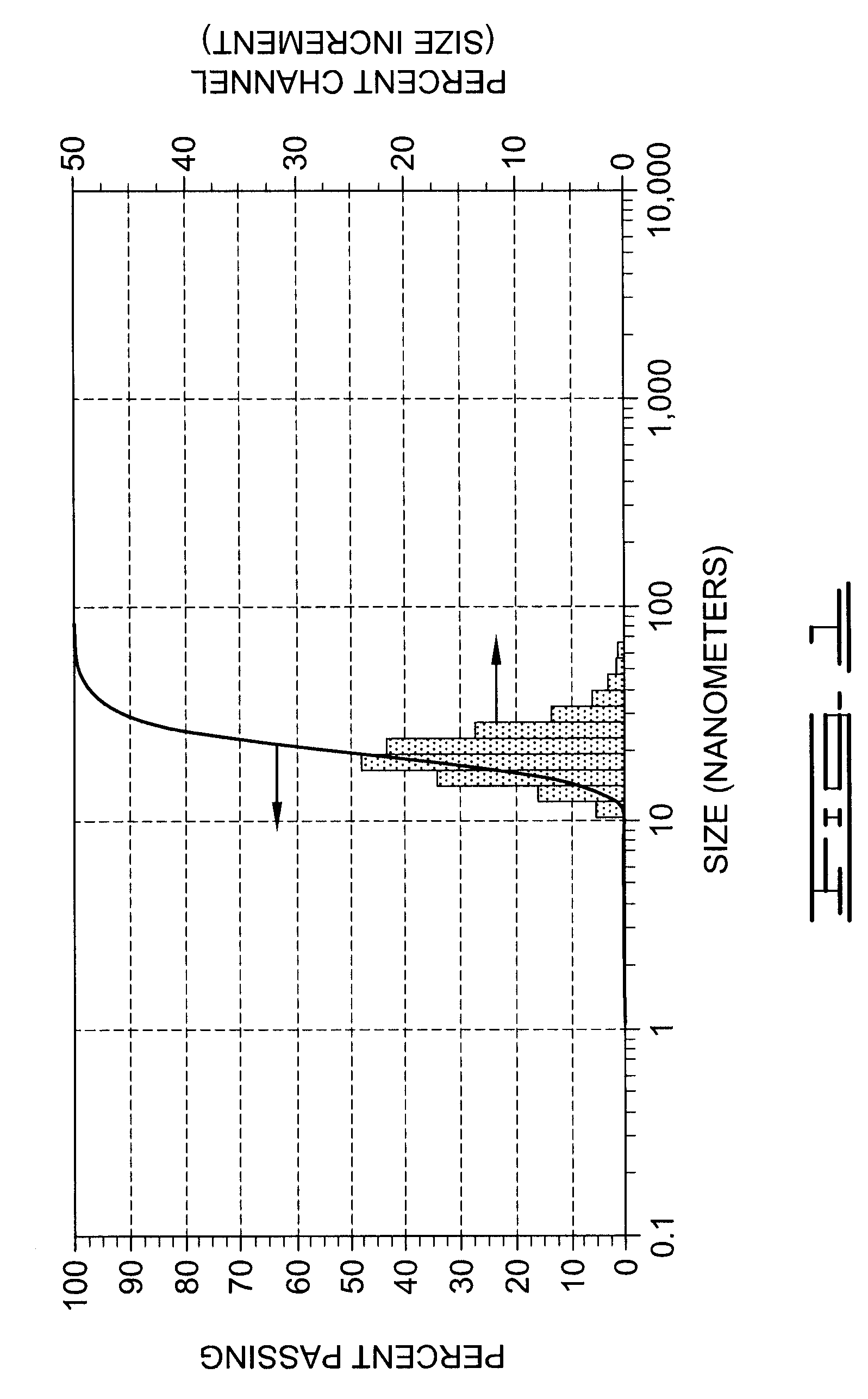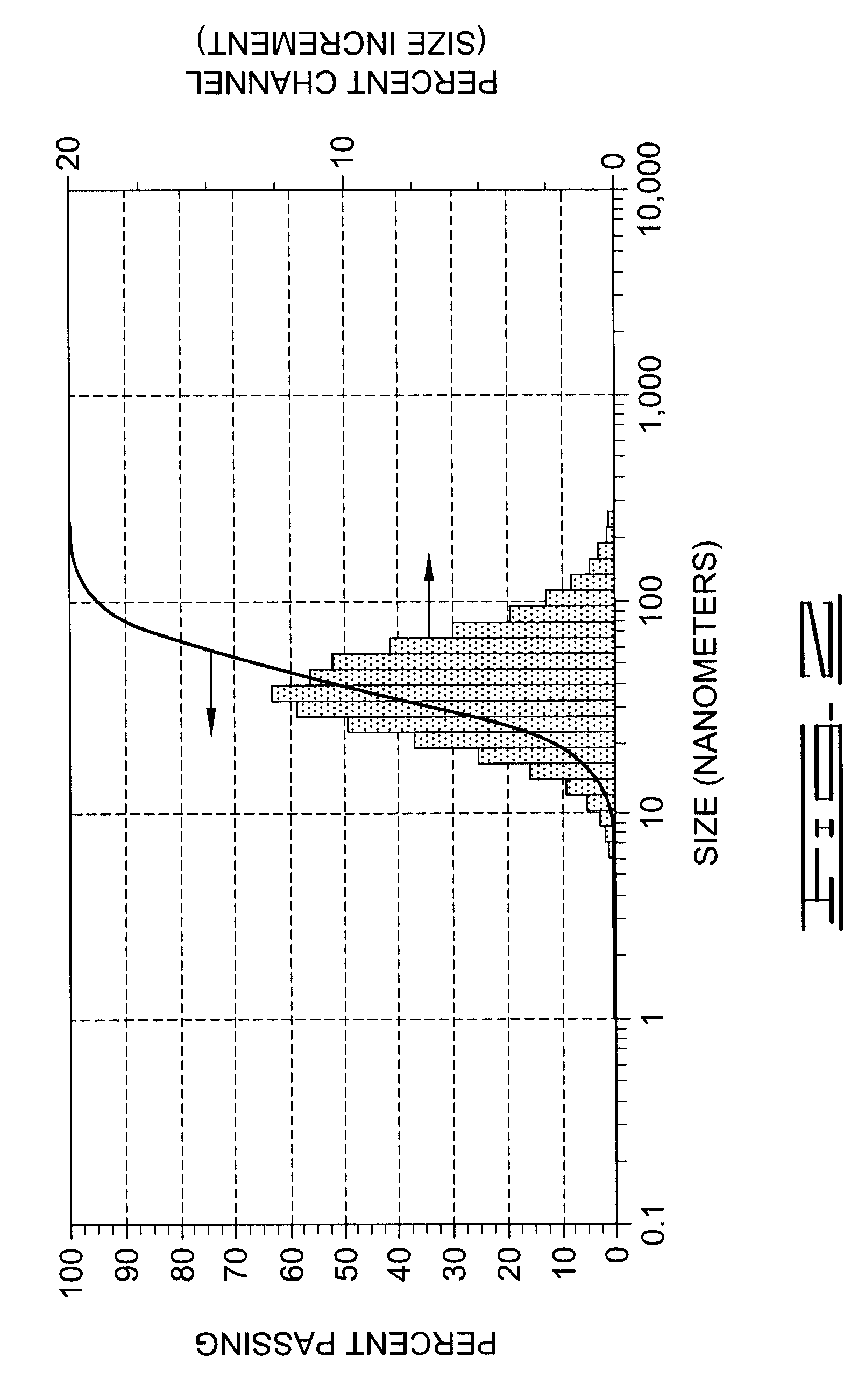Single step milling and surface coating process for preparing stable nanodispersions
a nanoparticle and single-step technology, applied in the field of single-step milling and surface coating process, can solve the problems of agglomeration of nanoparticles, inability to produce stable dispersions, and high cost of prior art processes for producing nanoparticles, and achieve stable dispersion, improve the photostability and improve the effect of titanium dioxide nanoparticles
- Summary
- Abstract
- Description
- Claims
- Application Information
AI Technical Summary
Benefits of technology
Problems solved by technology
Method used
Image
Examples
example 1
[0052]In this experiment, a 0.5 L MiniCer laboratory grinding system (available commercially from Netzsch, Inc.) is used. Feed particles of commercially available anatase pigment having an average primary particle size of 0.25 micron are mixed with deionized water and reagents to form about 350 mL of slurry comprising 15 wt % anatase, 10 wt % citric acid, and 5 wt % Darvan®7-N (ammonium polyacrylate). The pH is adjusted to 9.2 with aminomethyl propanol (AMP-95™). The slurry is mixed for 5 hours in a disperser using a high shear mixer. The mill is filled with about 150 mL of YTZ® grinding media (yttrium stabilized zirconia) having a particle size of 0.05 mm. The dispersed slurry is then fed continuously through the mill and recirculated through the disperser. The disperser is water cooled to maintain a temperature between 20° C. to 30° C.
[0053]The feed particles are milled for 30 minutes after which a sample is removed and analyzed for particle size distribution using a NanoTrak™ par...
example 2
[0054]A 10-liter bead mill from Netzch, Inc. is used to mill a commercially available anatase pigment having an average primary particle size of about 0.25 micron and an agglomerated particle size of about 1.5 micron. The pigment is mixed with deionized water and reagents to form about 60 gal of slurry comprising about 45 wt % anatase, and 5 wt % reagents. Reagents include citric acid and Darvan®7-N. The pH is adjusted to about 9 with aminomethyl propanol (AMP-95™). The slurry is dispersed for about 4 hours in an 80 gal disperser equipped with a high shear mixer. The mill is about 90 vol % charged with YTZ® grinding media having a particle size in the range of 100 to 200 micron and finer. The dispersed slurry is then fed continuously through the mill and recirculated through the disperser while maintaining the temperature at less than about 45° C. to avoid damage to synthetic materials in the mill. After 5-6 hours, surface areas exceeding 500 m2 / cm3 are achieved and the resulting di...
example 3
[0055]The procedure described in Example 2 is modified such that the slurry initially contains only a portion of the anatase feed particles and reagents in a 25% solids slurry. The initial slurry is dispersed for 1-2 hours and then circulated through the mill in closed loop with the disperser for several additional hours, after which the remaining anatase feed particles and reagents are added to the slurry. The resulting slurry contains 55% solids by weight and is circulated through the mill for several additional hours giving a total milling and dispersion time of about 5-6 hours.
[0056]FIG. 2 shows a product particle size distribution using the above procedure. The broad nature of the particle size distribution is more pronounced. Such a broad distribution can be very desirable for screening both UVA and UVB in sun screen formulations and applications. In addition, it is possible to produce a stable and very high solids dispersion of titania nanoparticles.
PUM
| Property | Measurement | Unit |
|---|---|---|
| particle size | aaaaa | aaaaa |
| particle size | aaaaa | aaaaa |
| particle size | aaaaa | aaaaa |
Abstract
Description
Claims
Application Information
 Login to View More
Login to View More - R&D
- Intellectual Property
- Life Sciences
- Materials
- Tech Scout
- Unparalleled Data Quality
- Higher Quality Content
- 60% Fewer Hallucinations
Browse by: Latest US Patents, China's latest patents, Technical Efficacy Thesaurus, Application Domain, Technology Topic, Popular Technical Reports.
© 2025 PatSnap. All rights reserved.Legal|Privacy policy|Modern Slavery Act Transparency Statement|Sitemap|About US| Contact US: help@patsnap.com


